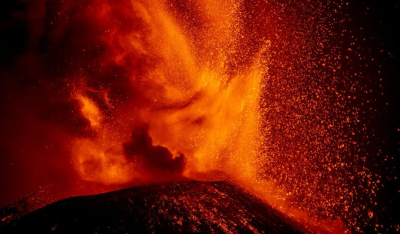Basalt volcanoes spew out very runny lava that travels fast and far. Image: Salvatore Allegra Photography via Getty Images
SPACE — Volcanoes that sit within Earth’s tectonic plates don’t erupt as scientists predict. New research says magma inside the volcano there is pushed up by carbon dioxide and out of the ground. Initially, scientists thought the magma was being pushed up by water.
This magma also erupted from a much deeper reservoir than previously thought. It originates in the earth’s mantle at a depth of 20 to 30 kilometers, not in the outer crust at 7 to 13 km.
“This completely changes the paradigm of how these eruptions occurred,” said study co-author Esteban Gazel, a professor of engineering in the Department of Earth and Atmospheric Sciences at Cornell University.
Scroll to read
Scroll to read
“All volcanic models are dominated by water as the main driver of the eruption, but the water has nothing to do with these volcanoes. It’s the carbon dioxide that carries this magma from deep within the Earth.”
The researchers suggest that CO2 could fuel this type of eruption. That suggests highly explosive eruptions don’t always have the highest concentration of water in the lava, but the new study finally confirms this theory.
The discovery relates to basaltic volcanoes that are inside tectonic plates, not on their edges. Basalt volcanoes spew lava that has a lower viscosity than other volcanoes, meaning it is more fluid and moves faster. These volcanoes can be very explosive when they erupt, especially if the lava is relatively cool and rushes to the surface quickly. Doing so can lead to crystals forming, and then being catapulted across the landscape.
According to the new research, despite forming more than half of the world’s volcanoes, basaltic volcanoes are still little studied compared to those that produce viscous lava.
Better Planning
Examples of basaltic volcanoes include Kilauea and Mauna Loa volcanoes in Hawaii. This includes Pico do Fogo, a volcano on the island of Fogo in the Cabo Verde archipelago in the Atlantic Ocean.
According to the study, Pico do Fogo is one of the most active island volcanoes in the world. Pico do Fogo has had 30 recorded eruptions since records began in the 15th century. The last eruption ended in 2015 after coating molten lava on more than 4 square kilometers of land and two villages.
The researchers analyzed the composition of the small pockets of molten lava trapped in the rocks at Fogo and found that they contained high amounts of CO2. That CO2 has crystallized at a pressure consistent with a depth of 12 to 19 miles. This implies that magma has been rising from within the mantle, not from the crust. Meanwhile, researchers think the separation of water into gas and liquid pushes magma upward through the ground. The process known as exsolution occurs in the Earth’s crust. Taken together, these results suggest CO2 bubbles pushing magma up from deep within the mantle.
“We used to think that all the action took place in the crust. Our data implied that magma was coming straight from the mantle, passing quickly through the crust,” said Gazel.
Lead author of the study, Charlotte DeVitre, now a postdoctoral researcher at the University of California, Berkeley, said at the Fogo volcano, magma had to be pushed up rapidly by carbon dioxide. That likely played an important role in his explosive behavior. “Magma has a very low viscosity,” he said.
This discovery could help reduce the danger posed by the eruption. “Because deep magma deposits will not be detected by soil deformation until melting approaches the surface. This has important implications for our understanding of volcanic hazards,” said Gazel.
Gazel added that scientists could develop much better plans for such eruptions in the future with the right measurements. That tells us where the eruption started, where magma melted and where it was deposited, and what triggered the eruption,” he said. Source: Live Science
“).attr(
type: ‘text/javascript’,
src: ‘
).prependTo(“head”);
if ($(“.instagram-media”).length > 0)
$(”
2023-08-08 12:51:39
#Scientists #Magma #Kilauea #Mauna #Loa #Eruptions #Turns #Earths #Mantle #space

